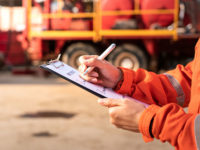Corrie Pitzer, a regular speaker at the National Safety Congress & Expo, kicked off Tuesday’s agenda with a “preview” of the opportunities and risks confronting safety and health professionals in a post-Covid world.
Right now, with all the Covid protections and protocols, Pitzer said there exists a certain paralysis by protection. We feel comfortable and confident. Of course, the danger is that this can lead to complacency and risk-taking. But Covid has also produced what he called, “risk paralysis.” “We are paralyzed by fear,” he said.
One consequence Pitzer predicted is by 2030 depression will be the number one global disease. “The lack of human connectivity is getting to us. There’s no hugging, no gossip around the water cooler. We’re living our world behind screens, computer screens, Zoom calls.”
But in every crisis lies opportunity, Pitzer said. “We are at a point where we can choose opportunity and innovation or remain in the past.”
Innovation often follows crises, and Pitzer used World War II as an example. After the war came computers, radar, penicillin, suburban communities built overnight, the interstate highway system, and more. After Covid we’ve seen innovation: curbside pickup, working from home as a normal way of working, and much more virtual interaction,
Ahead lies more innovation in safety, Pitzer said. Micro learning and online learning are making classroom training go by the wayside, he said. Toolbox talks that bore many workers Pitzer called useless and will be replaced with virtual toolbox talks via an app on your cellphone. Team members will be in on the call, get their assignments, discuss safety issues, and have a short Q&A. Team members can be quizzed or addressed individually. Some team members may be sent virtual reality animation or drone video footage showing potential hazards.
Out in the field, workers, some at least, will be outfitted with “smart” safety glasses that will show how the job is to be done, any outstanding work orders or safety issues, and enable wearers to report back on anything unexpected that turns up.
Not only is this an opportunity for micro learning of how to do a job, it will enable risk assessments and risk management to be done in real time using information displayed on the lenses of the glasses. Advanced safety metrics will be sent to team members in a tight virtual community of app users.
“We are living in the age of acceleration, and all this is coming quickly,” Pitzer said. “We are at the threshold of doing amazing things in safety. The new risk professional, safety professional, can embrace the new technology” or live in the past.
But innovation comes with some safety risks. Artificial intelligence will be driving cars in 25 years, Pitzer said, but there is a danger: AI is not programmed to make moral decisions. And safety is very often a matter of moral decisions. Another threat: work cultures could implode due to the lack of human touch, human connectivity. “We can’t lose human integrity and human touch,” he said.




